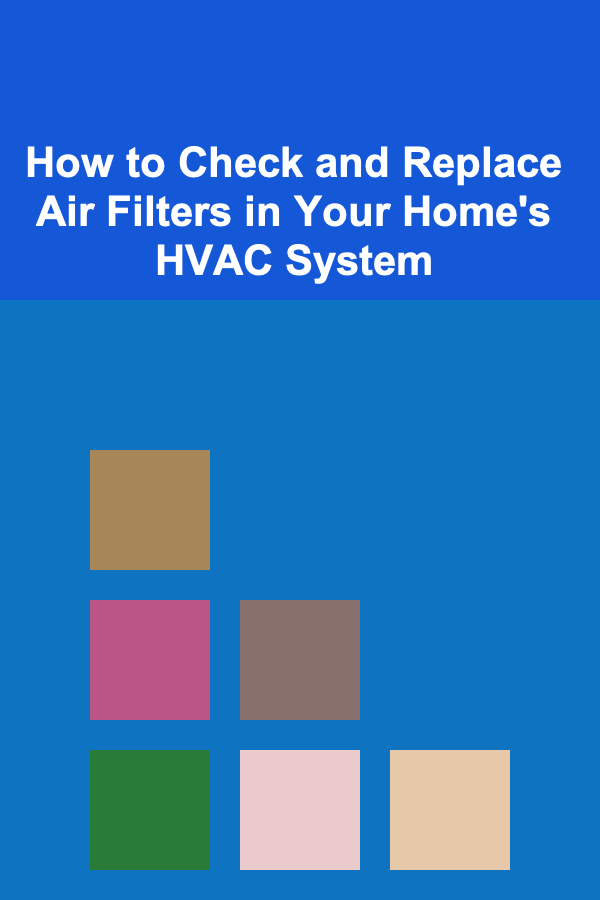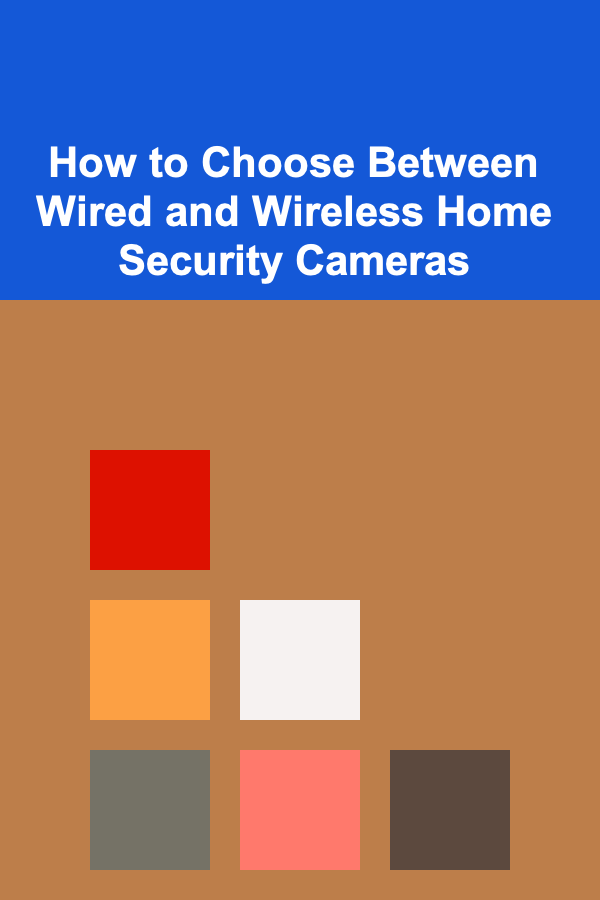
How to Check and Replace Air Filters in Your Home's HVAC System
ebook include PDF & Audio bundle (Micro Guide)
$12.99$7.99
Limited Time Offer! Order within the next:

Air filters play a crucial role in maintaining the efficiency, health, and safety of your home's HVAC (Heating, Ventilation, and Air Conditioning) system. They trap dust, debris, and other particles in the air, preventing them from circulating throughout your home. Over time, however, air filters become clogged with dirt, reducing their effectiveness and putting unnecessary strain on your HVAC system. This can lead to poor air quality, higher energy bills, and even system breakdowns.
Regularly checking and replacing air filters is an essential part of home maintenance that every homeowner should be familiar with. In this article, we'll dive deep into how to properly check and replace air filters in your HVAC system, the importance of maintaining them, and the consequences of neglecting this task.
Why Are Air Filters Important in HVAC Systems?
Air filters in HVAC systems serve as a protective barrier, capturing dust, pollen, pet dander, and other airborne particles before they can circulate throughout your home. This not only improves air quality but also prevents these particles from accumulating inside the HVAC system, such as in the coils and ducts. Clean filters help the system run more efficiently, which can extend the lifespan of the HVAC unit and reduce the risk of costly repairs.
The importance of air filters in HVAC systems cannot be overstated for several reasons:
- Improved Indoor Air Quality: Filters capture allergens, pollutants, and particulate matter in the air, reducing the risk of respiratory issues, particularly for people with asthma or allergies.
- Increased Energy Efficiency: When the filter is clean, the HVAC system doesn't have to work as hard to push air through. A clogged filter forces the system to work harder, leading to higher energy consumption and increased utility bills.
- Protection of HVAC System: Clean filters reduce the amount of dust and debris circulating through your system. This can prevent damage to the fan and coils, as well as the growth of mold and bacteria inside the unit.
- Extended Lifespan of the System: Replacing dirty filters can help extend the life of your HVAC system by reducing strain and wear and tear on internal components.
Types of Air Filters
There are various types of air filters available for HVAC systems, each with different levels of filtration efficiency. Understanding these can help you choose the right one for your needs.
- Fiberglass Filters: These are the most basic and affordable filters. They capture larger particles, such as dust and debris, but are not highly effective at filtering smaller particles or allergens.
- Pleated Filters: Pleated filters are made from a folded material that increases the surface area for trapping particles. They are more effective than fiberglass filters at capturing finer particles, making them a better choice for people with allergies or asthma.
- High-Efficiency Particulate Air (HEPA) Filters: HEPA filters are the most efficient in trapping small particles, including allergens, dust mites, and pet dander. They are ideal for homes with sensitive individuals, but they may be more expensive and may require a special HVAC system that can accommodate them.
- Electrostatic Filters: These filters use static electricity to attract and trap particles in the air. They are washable and reusable, making them a more sustainable option, but they can be more expensive initially.
- Carbon Filters: Carbon filters are designed to remove odors and gases, such as cooking smells and smoke. They are often used in conjunction with other filters for enhanced air quality.
Each type of filter has its advantages and drawbacks, so it's essential to choose the one that best suits your needs. In most homes, a pleated filter or HEPA filter is sufficient for maintaining clean air while ensuring the HVAC system functions efficiently.
How to Check Your HVAC Air Filter
Checking your HVAC system's air filter is a simple task that can be performed in a few steps. By regularly inspecting the filter, you can determine when it needs to be replaced before it becomes clogged and starts to impact the system's performance.
Step 1: Locate the Air Filter
The first step is finding the location of your air filter. This will vary depending on the type of HVAC system you have. In most forced-air heating and cooling systems, the filter is located near the return air duct or the blower compartment. Common locations include:
- Return air grille: In some homes, the air filter is located behind a return air vent on the wall. You can simply remove the vent cover to access the filter.
- Blower compartment: For many systems, the filter is located inside the blower compartment, which is often found near the furnace or air handler. You may need to remove a panel to reach the filter.
- Air handler or furnace: In other cases, the filter is located near the air handler or furnace itself.
Once you've identified the location of the filter, remove any grille or panel to access it.
Step 2: Inspect the Condition of the Filter
Once the filter is exposed, remove it from the housing. Take a moment to inspect the condition of the filter. Here's what you should look for:
- Dust and Debris: If the filter appears to be covered in dust and debris, it's a sign that it needs to be replaced. Depending on the type of filter, a thin layer of dust may be normal, but a heavily clogged filter can significantly impact air quality and system efficiency.
- Visible Damage: Check the filter for any visible signs of damage, such as tears, rips, or deformities. If the filter is torn or damaged, it will not perform as effectively, and you should replace it immediately.
- Color: A filter's color can provide clues as to how much dirt it has accumulated. If it has turned brown or gray from the buildup of dust and debris, it's time to replace it.
- Airflow: Some filters are designed to show when they are clogged by restricting airflow. If you notice that the airflow coming from the vents feels weaker than usual, this may be a sign of a clogged filter.
Step 3: Measure the Filter Size
Before replacing the filter, you should measure the size of the existing filter to ensure you purchase the correct replacement. Most air filters will have the size printed on the side, but if not, you can measure the filter yourself. The three most common measurements are length, width, and thickness (depth).
Filters typically come in standard sizes, but it's always a good idea to double-check the measurements to avoid purchasing the wrong filter.
How to Replace an HVAC Air Filter
Replacing your HVAC air filter is a simple task that only takes a few minutes but can greatly improve the performance and efficiency of your system. Here's a step-by-step guide to replacing the filter.
Step 1: Turn Off the HVAC System
Before you begin, make sure to turn off your HVAC system. This is an essential safety step to avoid injury or damage to the system while you're working on it.
Step 2: Remove the Old Filter
Carefully remove the old filter from the housing. If the filter is stuck or difficult to remove, gently pull it out without forcing it. If the filter is too dirty or clogged, some dust may fall off when you remove it, so be cautious.
Step 3: Insert the New Filter
Take the new filter and check its orientation. Most filters have an airflow direction indicated by an arrow on the side. Make sure to insert the filter with the airflow arrow pointing toward the blower or toward the direction in which the air is being pulled into the system.
Carefully slide the new filter into the housing. Make sure it fits snugly and securely in place without bending or warping. If the filter is too large or too small for the slot, it may not seal properly, which could reduce its effectiveness.
Step 4: Close the Housing and Turn on the System
Once the new filter is in place, close the panel or grille that covers the filter housing. Turn your HVAC system back on and check to ensure that it is working properly.
How Often Should You Check and Replace Your Air Filter?
The frequency with which you should check and replace your air filter depends on several factors, including the type of filter, the amount of use your HVAC system gets, and the air quality in your home. However, a general guideline for replacing filters is:
- Fiberglass filters: Every 30 days
- Pleated filters: Every 60 to 90 days
- HEPA filters: Every 6 to 12 months (depending on usage and environmental factors)
- Electrostatic filters: Every 3 to 6 months
- Carbon filters: Every 30 to 60 days
If you have pets, live in a dusty area, or suffer from allergies, you may need to replace the filter more frequently. In contrast, if you live in a less polluted environment and use your HVAC system sparingly, you may be able to go longer between replacements.
Consequences of Neglecting to Replace Air Filters
Neglecting to regularly replace or clean your HVAC system's air filters can have several negative consequences, including:
- Poor Air Quality: A dirty filter cannot trap dust, allergens, or bacteria effectively, which leads to poor air quality and potentially exacerbates health issues like asthma, allergies, or respiratory problems.
- Higher Energy Bills: A clogged filter forces the HVAC system to work harder, which results in increased energy consumption. This can lead to higher utility bills.
- HVAC System Damage: A dirty or damaged filter can cause debris to accumulate in the HVAC system, potentially damaging internal components such as the blower fan, coils, and motors.
- Shortened Lifespan of the System: Constant strain on the system due to clogged filters can lead to premature wear and tear, ultimately shortening the lifespan of the HVAC unit.
Conclusion
Regularly checking and replacing the air filter in your HVAC system is a simple but essential maintenance task that can save you money, improve air quality, and extend the life of your system. By following the steps outlined in this article, you can ensure that your HVAC system operates efficiently and effectively, providing you with clean air and optimal comfort year-round. Whether you're a first-time homeowner or a seasoned DIYer, understanding how to maintain your air filters will keep your home and HVAC system in top condition.
Reading More From Our Other Websites
- [Home Renovating 101] How to Choose Lighting Fixtures That Enhance Your Space
- [Organization Tip 101] How to Set Up a Plant Care Station in Your Hobby Room
- [Home Renovating 101] How to Renovate Your Home for Better Indoor Air Quality
- [Personal Investment 101] How to Successfully Implement House Hacking to Accelerate Your Real Estate Investing Journey
- [Gardening 101] Designing a Butterfly Garden: Tips for Every Season
- [Tiny Home Living Tip 101] Best Multi‑Functional Furniture Ideas to Maximize Tiny Home Space
- [Home Staging 101] How to Stage Your Home to Appeal to Eco-Conscious Buyers
- [Home Space Saving 101] How to Maximize Bathroom Space with Clever Storage Solutions
- [Home Holiday Decoration 101] How to Repurpose Everyday Items for Holiday Decorations
- [Survival Kit 101] Why You Should Consider a Pre-Built Survival Kit for Your Emergency Plan

10 Effective Ways for Lowering Health Insurance Premiums
Read More
How to Choose Between Wired and Wireless Home Security Cameras
Read More
How to Organize Your Pantry for Easy Meal Prep
Read More
How to Confidently Handle Sensitive Information as an Executive Assistant
Read More
How to Adapt Your Home for a Client with Limited Mobility
Read More
10 Tips for Creating a Low-Maintenance Garden Plan
Read MoreOther Products

10 Effective Ways for Lowering Health Insurance Premiums
Read More
How to Choose Between Wired and Wireless Home Security Cameras
Read More
How to Organize Your Pantry for Easy Meal Prep
Read More
How to Confidently Handle Sensitive Information as an Executive Assistant
Read More
How to Adapt Your Home for a Client with Limited Mobility
Read More